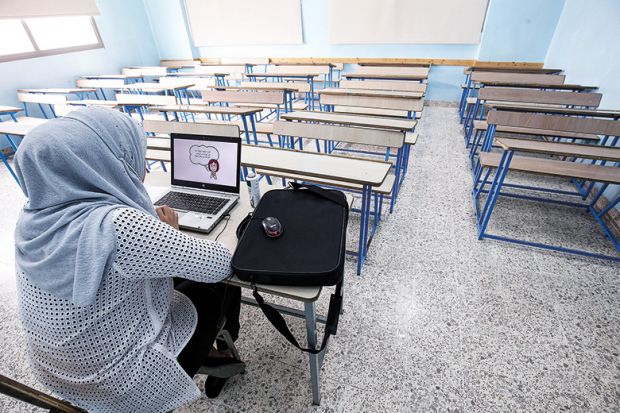To coincide with the launch of Times Higher Education’s Arab University Ranking, we’re publishing a series of comment pieces focusing on the Arab world. Browse the THE Arab University Rankings 2022 results.
The beauty of the modern “open university” model is that it uses the internet and technology to make education affordable, effective and accessible to all.
Inherent in the definition of an “open university” – whether it is a fully or partially online university – is an institution that limits legal, technical and financial barriers in the provision of education. This means that the certificate or degree received is legally recognised; both the learner and the provider have sufficient technical capabilities to access and provide online learning; and the price point is such that learners find it affordable and providers cover their costs. So how should we approach a sustainable model for open education in the Middle East and North Africa (MENA)?
While governmental recognition of these new modes of education is critical to their introduction and functioning, stakeholder recognition of the programmes is also fundamental to their sustainability. In that regard, there are three main players – students, universities and employers.
For students, the key to programme sustainability is validity and relevance. Students not only wish to enrich their knowledge but to strengthen their skill sets and present themselves as job-ready. In the MENA area, youth unemployment is at 26 per cent, according to the World Bank. As such, students seek degrees and certificates that provide relevant skills which can be easily validated by employers, both within and outside the region.
For universities, particularly those in MENA, sustainability within the open university model will come from established higher education institutes using their reputation as an imprimatur of quality.
Established universities can also leverage benefits from the open university model. To do this they should engage in an intentional path of change. For example, my university, the Lebanese American University (LAU), first approached open education by breaking down internal barriers. Through the establishment of the Center for Innovative Learning, LAU was able to bring faculty from every discipline together around the common goal of introducing technology-enabled learning to their classes.
Once these internal barriers of both discipline and mindset were broken, LAU took it a step further. It introduced courses and minors that are unique to the university because they are taught by multidisciplinary teams of faculty, or attended by multidisciplinary cohorts of students. One example is the Liberal Arts and Science Curriculum, which is taught by a variety of faculty and embraces the UN’s Sustainable Development Goals, and another is a minor in data analytics which is relevant to a diverse set of learners and open to all majors.
In the next step towards open education, LAU opened the doors of several classrooms to the world through targeted virtual exchange experiences embedded in key courses. One such experience involved students in LAU’s Data Driven Design Thinking Course partnering with students from Boise State University in Idaho, US. As LAU continues its trajectory toward open education, it has left the traditional walls of the classroom behind through its offer of four fully online master’s degree programmes and two certificates.
In these online programmes, students truly benefit from the perfect meld of a traditional and online institution. They have access to all the quality resources of the libraries, student centre and student support alongside the flexibility of remote learning.
We now return to the third key stakeholder group in the triptych of open university success: employers. For open education to be sustainable in MENA, employers must embrace the idea that an employee’s knowledge and skills are more critical than the piece of paper that says the employee has that knowledge and those skills. This is critical as many governments have yet to legally recognise degrees and certificates earned online – yet the knowledge and skills gained by an individual through these programmes are no less real.
In this regard, many employers may consider partnering with universities to ensure that their curricula and assessments are commensurate with their needs. One model by which this could work is through programme sponsorship – which brings us to the concept of open education being free from financial barriers.
The term “open education” does not mean free education. Significant technical and human infrastructure is needed for the production of online educational resources, and somebody must bear the cost. In a traditional model of education, it is the student who bears this.
When considering a sustainable model of open education, a cost-sharing arrangement is a must. For example, pricing can be set based on the cost of creating the content and the ability of the student to pay after an offset through grants or corporate sponsorship. Of course, an educated citizenry is a productive citizenry, and thus governments should also play their part in alleviating financial barriers to quality education.
Through the engagement of multiple stakeholders across MENA in the open production and consumption of knowledge, we can truly honour the roots of the word university – “one community”.
Jordan Srour is assistant provost of educational resources and innovation at the Lebanese American University.
POSTSCRIPT:
Print headline: ‘Open’ road can be ours
Register to continue
Why register?
- Registration is free and only takes a moment
- Once registered, you can read 3 articles a month
- Sign up for our newsletter
Subscribe
Or subscribe for unlimited access to:
- Unlimited access to news, views, insights & reviews
- Digital editions
- Digital access to THE’s university and college rankings analysis
Already registered or a current subscriber? Login








